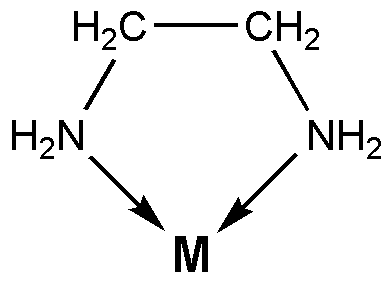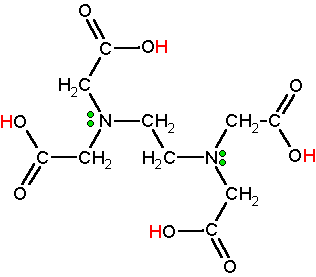Coordination Compounds
Table of Content |

What are Coordination Compounds?
The compounds which retain their identities even when dissolved in water or in any other solvent where the properties are completely different from those of the individual components are called Coordination Compounds.
Coordination compounds example: [Ni(NH3)6]Cl2, [Co(NH3)6]Cl3.
Why [Ni(NH3)6]Cl2 is a Coordinate Compound?
[Ni(NH3)6]Cl2 is formed by following process:
When aqueous ammonia is added to a green solution of nickel chloride, the colour changes to purple .The Ni+2 almost disappear from the solution and ammonia enters into an intimate association with Ni+2 to yield a new ion [Ni(NH3)6]+2. This ion is also called Complex Ion.
6NH3 (aq) + NiCl2 à [Ni(NH3)6]Cl2
On evaporation of this solution, a purple crystals of above formula is produced.
Fig. [Ni(NH3)6]CI2 Structure
Now, if this compound is dissolved in water, there is no evidence for the existence of free Ni+2 ions or ammonia molecules. The properties of the complex compound is entirely different from those of Ni+2 ions or ammonia molecules. Hence this compound is called a Coordinate Compound.
Note: Coordination Compound can also be called as Complex compound.
This compound ionise in solution as

Now a days, a large number of complex compounds of different types are known, like a precipiate of AgCN when dissolve in solution of KCN, gives a soluble coordination compound K[Ag(CN)2].
AgCN + KCN → K[Ag(CN)2].
Q1. What is Complex Chemistry?
Sol. The branch of chemistry that deals with the study of the Coordination Compounds or Complex Compounds and their uses is termed as 1.
Q2. Why do transition metal compounds forms complexes?
Sol. The transition metals are almost unique in their tendency to form coordination complexes. The tendency of cations of transition elements to form complexes is due to two factors;
-
These ions are very small in size and, therefore, have high positive charge density. This facilitates acceptance of lone pair of electrons from other molecules.
-
They have vacant orbitals and these orbitals have the appropriate type of energy to accept lone pair of electrons.
Q3. What is a Coordinate Bond?
Sol. When both the electrons are being shared between the atoms are contributed by one atom only, then this type of bond is called Coordination Bond. It is also called Dative Bond.
A coordinate bond established between two atoms; one of which has a complete octet with at least one pair of unshared electrons while the other is short of two electrons. The Coordinate Bond is shown by (a) sign.
Example: Formation of hydronium ion from water molecules. In this, oxygen atom in water molecule is the donor and hydrogen ion is the acceptor.
Some terms used in Explaining Coordinate Compounds
-
Complex Ion : An electrically charged ion which consist of a central metal atom/ion surrounded by a group of ions or neutral atom is termed as complex ion.
Example: Ni(NH3)6]+2 is a complex ion in which Ni+2 is the central metal atom surrounded by six ammonia molecules.
-
Central Ion and Ligand: The cation to which one or more neutral molecule are coordinated is called the Central Ion and the attached molecules are called Ligands.
Example: So in [Ni(NH3)6]+2 Ni+2 is the central ion surrounded by ammonia ligands.
-
Coordinate Number: The total number of ligands attached to a central metal ion/atom is called the Coordinate Number of that particular ion.
Example: In complex ion [Cu(NH3)4]+2, 4 ammonia ligand are attached to the central metal ion Cu. Hence the coordination number of Cu+2 ion in above complex ion is 4.
-
Coordinate Sphere: The central metal ion together with molecules or ion coordinated to it is termed as Coordinate Sphere. It is written inside a “[ ]” square bracket.
Example: [Ag(CN)2]- is a coordinate sphere.
-
Ion and the Ligands Coordinated to it.
Example: In complex ion [Cu(NH3)4]+2 , Cu+2 carries a charge of +2 and ammonia molecule is neutral ,hence the total algebraic sum of these two are +2 . Thus [Cu(NH3)4]+2 carries a charge of +2.
Types of Ligands
A ligand contains one or more than one donor atoms for coordination with the central ion, accordingly which is classified below:
-
Unidentate or Monodentate Ligand: The ligands which can donate only one pair of electrons and hence can only be coordinated to the central ion through only one atom, are known as Unidentate or Monodentate Ligand.
Example: NH3,H2O,Cl-, Br-,NO2- etc.
-
Bidentate Ligands: The ligands which have two donor atoms and hence have the tendency to attach with central ion through two donor atoms are called Bindentate Ligand.
Example: Oxlate anion, ethylenediamine etc.
 |
 |
| Fig.1: Oxlate anion | Fig. 2: Ethylenediamine |
-
Polydentate Ligands: The ligands which coordinates with the central ion through more than two donor atom present in the molecules are called Polydentate Ligands.
Example: EDTA (Ethylene Diamine Tetracetic Acid) is an important hexadentate polydentate ligand. It binds through two nitrogen and four oxygen atoms of the four COOH group to a central metal ion.
Fig: EDTA (Ethylene Diamine Tetracetic Acid)
- Chelating Ligands and Chelates: When a bidentate or a polydentate ligand is attached through two or more donor atoms to the same central metal ion to form a ring structure, the ligand is thus called a Chelating Ligands and hence the resulting complex is termed as a chelate.
Example: When ethyldiamine, a bidentate ligand coordinates through both the nitrogen atoms and results in the formation of a ring structure, is called A Chelating Ligand and The Complex Forms [Cu(NH2CH2NH2)2]+2 is a chelate ion.
 |
 |
|
Fig.1: Bidentate ligand acting as a chelating ligand. |
Fig.2: Chelate cation |
Applications of Coordination Compounds
Coordination compounds are widely use now days.Some of their applications are listed below:
-
Extraction process of gold and silver
-
Used as a catalyst in many industrial processes.
Example: Nickel, Copper can be extracted by using hydrometallurgical process involving coordination compounds.
-
Used in hardness of water.
Example: EDTA (Ethylenediaminetetraacetate) is used in the estimation of Ca+2 and Mg+2 in hard water.
-
Cyanide complexes are used in electroplating.
We will discuss the basic of coordination compounds in more detail under following sub topics
Watch this Video for more reference
Frequently Asked Questions(FAQs)
Q1. Mohr’s salt is
a. Double salt
b. Coordination compound
c. Both
d. None
Q2. Secondary valancy of [Cu(NH3)4]2+ is
a. 1
b. 2
c. 3
d. 4
Q3. Total number of legand in [Cr(H2O)4Cl2]+ is
a. 6
b. 4
c. 2
d. 1
Q4. EDTA. is
a. Unidentate ligands
b. Bidentate ligands
c. Ridentate ligands
d. Hexadentate ligands
Q5. Carbonate ion(CO32–) acts as a
a. Tridentate ligand
b. Bidentate ligand
c. Monodentate ligand
d. Tetradentate ligand
Q6. Which of the following co-ordination number is unknown for Co3+?
a. 5
b. 4
c. 6
d. zero

|
Q.1 |
Q.2 |
Q.3 |
Q.4 |
Q.5 |
Q.6 |
|
b |
d |
a |
d |
b |
d |
Related Resources
-
Look here for past year papers of IIT JEE
-
Click here to refer syllabus of chemistry for IIT JEE
To read more, Buy study materials of Coordination Compounds comprising study notes, revision notes, video lectures, previous year solved questions etc. Also browse for more study materials on Chemistry here
View courses by askIITians


Design classes One-on-One in your own way with Top IITians/Medical Professionals
Click Here Know More

Complete Self Study Package designed by Industry Leading Experts
Click Here Know More

Live 1-1 coding classes to unleash the Creator in your Child
Click Here Know More

a Complete All-in-One Study package Fully Loaded inside a Tablet!
Click Here Know MoreAsk a Doubt
Get your questions answered by the expert for free
![[Ni(NH3)6]Cl2 Structure [Ni(NH3)6]Cl2 Structure](https://files.askiitians.com/cdn1/images/20161128-164226993-3362-2-coordination-compounds.png)

